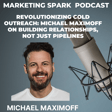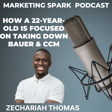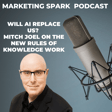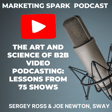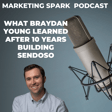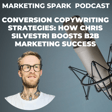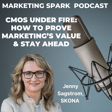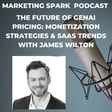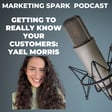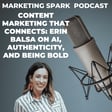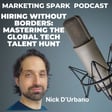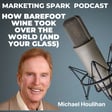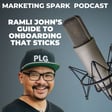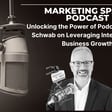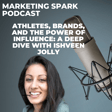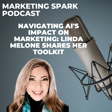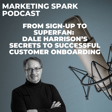Become a Creator today!Start creating today - Share your story with the world!
Start for free
00:00:00
00:00:01

From Pitch to Publish: How PR Monkey is Redefining the PR Game
This episode takes a dive deep into the intersection of technology, innovation, and public relations.
Mark Evans, seasoned B2B/SaaS marketer and ex-journalist, sits down with Nima Olumi, one of the co-founders of PR Monkey.
As they unpack the challenges of modern PR, you'll gain insight into how technology is shaping the future of communications, branding, and storytelling.
Whether you're a PR professional, an aspiring entrepreneur, or just curious about the world of tech-driven communications, it is a conversation that delivers a big-time knowledge and inspiration.
Transcript
Introduction to Marketing Spark
00:00:08
Speaker
Hi, it's Mark Evans, and you're listening to Marketing Spark, the podcast that features interviews with B2B and SaaS entrepreneurs and marketing leaders.
Nima's Entrepreneurial Journey
00:00:18
Speaker
In many respects, Nima Ulumi is living the entrepreneurial dream. He's leveraged the success of a services business, Public Relations, to launch a SaaS-based business, PR Monkey.
00:00:30
Speaker
It's a path that many entrepreneurs would love to pursue, but it's often a huge challenge to make happen. On today's podcast, I'm talking to Nima about his take on PR amid a volatile media landscape and his experience and lessons from launching PR Monkey. Welcome to Marketing Spark, Nima.
00:00:47
Speaker
Hey, what's going on? Thanks for the very kind intro. It's great to have you. Maybe we can start by sharing your background and the journey that led you to find like your strategies, your PR agency and PR monkey. What inspired you to start these ventures? Were you always an entrepreneur or was it something you stumbled into?
From Marketing to PR: The COVID Influence
00:01:07
Speaker
I would say I was always an entrepreneur. I had a gum dealing business when I was in sixth grade and I was plowing a lot of driveways in Boston when I would snow. I was knocking on doors and stuff. I always have a lot of entrepreneurial tendencies. Lightyear started out as a public, not as a public relations business, but as a marketing business.
00:01:25
Speaker
I kind of had the ADHD mindset of entrepreneurs and I was essentially just acting as a marketing head for various companies in New York City post-grad. And that was a really interesting gig. We were doing a lot of web design. We were doing a lot of lead generation tactics. We were doing a lot of copywriting, advertising design, advertising management.
00:01:43
Speaker
And we were kind of like a Swiss army knife, but a lot of people don't use a Swiss army knife to eat steak and stuff. I think we learned a lot. And then we found our niche in public relations at the very start of COVID because we were very fortunate to have a client that is a very large property management company in New York. And I convinced the CEO that they had a very interesting story to tell at the start of COVID. And we were able to get them published in the New York Times, Bloomberg, realtor.com, the real deal, tons of
00:02:11
Speaker
press and they were able to raise a $35 million round off a lot of those publications. I saw the firsthand value that we brought and what was lucky about that client is we had a really interesting story. So I just mined the data of reporters from the outlets and I just shotgun blast stuff to them. It was my first time doing it.
00:02:30
Speaker
We were very fortunate to have a client that trusted us to kind of experiment and always let me guinea pig different ideas and things like that from a marketing perspective. But ever since then, we saw the bang from that. We decided just to specialize in PR so that we could specialize in industry and really grow.
Birth of PRMonkey: Challenges and Team Dynamics
00:02:46
Speaker
Since early 2020, we've just been doing PR.
00:02:49
Speaker
three and a half years now. We've specialized in the public relations industry. Then I met our head of product just over a year ago at a dinner party. I was starting to dabble in the public relations software industry. We were just perplexed that a lot of the softwares that exist in our space are very archaic and old and very expensive. We started making investments in terms of designing a software that is more modern, has better
00:03:14
Speaker
updated technology, better data flows. That's how PRMonkey essentially came about and the products in a private beta right now, which is really exciting. We're 10 people full time, very heavy on the development front, not so heavy on the sales and marketing front. Eight of the 10 people on our team just build product. And we only have me and one other person who can sell and manage clients and stuff like that. We really appreciate guest appearances, what you're giving us here. Cause it's one of the ways to get the word out.
00:03:42
Speaker
I want to talk about PR Monkey, but first let's focus on the PR landscape. I was a journalist many years ago and that game was different because there was a lot of media, a lot more media. PR seemed to be an easier game to play because there was supply and demand.
00:04:01
Speaker
But the landscape has changed.
Navigating Client Expectations in PR
00:04:03
Speaker
PR has sold this magical thing for many entrepreneurs. They believe that if they hire a PR agency, they can get media coverage. Media coverage can attract the spotlight and customers. It can allow their business to grow quickly and then they'll be able to raise money. A lot of them
00:04:19
Speaker
think that PR is the silver bullet to a lot of their problems. But you and I know that that's not the case. Can you talk about some of the misconceptions and the challenges that you've encountered in helping companies understand the realities of PR, how it works, and establishing expectations? Because I think that
00:04:38
Speaker
Overnight success is really hard to if you can convince somebody that's investment over time as opposed to something that's going to produce instant results. That's a good approach. So talk to me a little bit about the PR landscape and how you establish that trust with clients about the job you're going to do for them.
00:04:54
Speaker
A lot of people have different perspectives and perceptions of what public relations mean. As a business, you have to cater your deliverables to what that client wants, whether that's views, domain authority, helping close more deals. One of the things that we try to do at Lightyear is to really focus on working with clients who have an interesting product.
00:05:15
Speaker
The vast majority of our clients are deep technology companies. We know how to program. I've taken a lot of programming courses. Our whole team knows a lot about high tech and things like that. We're really good at taking copy and making it amicable for the media. And sure, the media landscape has changed a lot. We really focus on companies that mostly sell B2B products. And a lot of the people who are decision makers and buyers in those space for those clients, they are pretty well-read people. They do read the press. They do read the news.
00:05:45
Speaker
And a lot of having a TechCrunch article or being in Bloomberg and having that third party validation can be the difference of when users come to your platform and sign up for your product or not. It depends on the kind of PR. There's influencer marketing with TikTok and Instagram. That's a form of PR. There's journalists and reporter PR, which is more traditional PR, more and more on the traditional front on the journalists and reporter side.
00:06:09
Speaker
But there's tremendous value that's brought that subtle. I would always say a company has to have the means to invest in a serious public relations campaign. If you're a two or three person show, you're just getting off the ground and you're debating whether to hire an SDR or a full-time PR company, probably go with the SDR. When that SDR starts booking meetings and having stuff and any potential clients coming through, if they have a good funnel and you don't have good media backing, you're losing a significant amount of customers on that. The question is,
00:06:39
Speaker
As we talked about PR can be very tempting.
00:06:42
Speaker
It's kind of this creature that's sexy and compelling. But how does a company know that it's ready for PR? You mentioned the fact that if they get some sales momentum, that could be a signal. What are some of the other signs that a company is ready to take the next step? Because it is a big leap and it does involve an investment. It's not something that they can invest a month in and back away. What are the signs that a company should be seriously exploring the idea of leveraging PR to move forward?
00:07:10
Speaker
You should probably have some sort of investor. You should have some minimal viable product that's ready for sale, I would recommend. It's very unfortunate in the public relations industry that sometimes we get companies who don't have a product that's ready and they're trying to hire a public relations agency to market it as ready.
00:07:26
Speaker
We have to be very wary of those sort of situations and do a significant amount of due diligence when we're taking on new clientele. And it's also why we deny a lot of business. It's not worth our time to get invested in someone who isn't serious. We do a tremendous amount of research and things like that before we take on clients to make sure that we are promoting.
00:07:43
Speaker
Accurate thorough information as a business owner myself It's always really helpful to see something from an outside or a third-party perspective a lot of CEOs are thinking I just want to hammer the nail Make it all about me me me and our company that's not gonna get as many genuine headlines as Something that's well thought out. That's not just direct propaganda. That's actually an interesting story So we focus a lot on pulling relevant statistics interesting storylines that are
00:08:12
Speaker
interesting to a general audience, but also in support of the company's best interest. Let's set the stage a little bit when you're onboarding a new client.
Crafting Effective PR Strategies
00:08:21
Speaker
Obviously, they would love to have instant success. They want media coverage in the short term. Every entrepreneur dreams about that. But how do you establish expectations in terms of this is the journey that we're going to go on? Ideally, you create a strategic partnership that is win-win.
00:08:41
Speaker
How do you set the stage in terms of, listen, we're looking at a three to six month campaign. It's going to begin with in-depth research into you and the competition and the story angles. We're going to do some research on pulling statistics and maybe leveraging trends. Then we're going to do these things. Map that out for me in terms of providing entrepreneurs with
00:09:04
Speaker
roadmap of how this thing is going to go. We do a tremendous amount of research before sending any pitches. A lot of PR companies spend 90 days doing research. We spend a week and a half, two weeks max. So we do a lot of research and we come up with different copywriting. What's the subject line that's going to resonate well with their target audience, whether they're trying to target tech influencers or
00:09:27
Speaker
fashion influencers. One of the most important things is what is a subject line that's just going to excite people in this industry? How can we quickly educate someone and pique their curiosity? That's how reporters, that's how writers, that's how influencers are. They're all creatives at heart. So how can you gain their interest and their respect?
00:09:44
Speaker
And then we test different various copy, and we try to come up with different formulas for different audiences and niches of influencers. Something that a fashion journalist would find interesting wouldn't be something that a tech journalist would find interesting, or more specifically, an AI journalist versus someone who programs, writes specifically on more backend information.
00:10:04
Speaker
or something. So you really should value your first impression to people. I think a good public relations person or company will do that. It depends on the client. Do they have a lot of inbound PR coming in?
Building Relationships in PR
00:10:16
Speaker
Are they looking to get more PR? We're more focused on helping people get coverage who want more news coverage. There's a lot of people who also get tons of news coverage and want PR companies to watch it and make sure it's not bad or they're
00:10:29
Speaker
help them answer the questions and stuff. I'm going to call you on your research process. A week and a half seems very agile, very, very agile research compared to a longer research cycle where you're trying to get a sense of the product in the competitive landscape, in the news landscape. How do you do that? I was consulting for companies since I was 20 years old. So
00:10:52
Speaker
trying this, trying that, jumping in the sky, trying this project. I've had a lot of experience taking products and trying to write copy for them or advertising for them. To me, I think it's not too hard. It just comes naturally, but I can understand if that process takes a little bit more time for people. We've made a process out of it, which is post statistics, check the competition, test various headlines,
00:11:14
Speaker
see what fits. It's common sense at this point. Every entrepreneur believes that their company is newsworthy. Every entrepreneur believes that if they hire a peer agency and they craft a good story, the journalists are going to come running. The reality is obviously there's a lot of competition for the attention of bloggers and journalists and influencers. The question is how much do personal relationships matter with reporters, bloggers, and
00:11:43
Speaker
influencers. So for example, if you know reporters at Inc or entrepreneur or the New York Times or the Washington Post, is that important? Does that make a difference? Does that separate one PR agency from another? Because I think relationships matter. When I was a journalist,
00:11:59
Speaker
I gave the PR people who I knew the time of day. I wouldn't look at the email and dismiss it or look at it later. I would actually say, okay, maybe there's something here. I trust you that we've got a relationship. But when a company is looking at a PR agency, what's the value of the relationships that the PR agency has and how you demonstrate that when you're trying to pitch a client that you really want? I would say PR people at their core are very well connected, very likable people.
00:12:28
Speaker
So we're very gregarious, social, we know how to bring value to parties, and we know how to deal with people. I would say relationships are very important. They're not the only thing that matters. I've seen some stats in the PR industry, but relationships don't matter. 95% of the value is the story. That's a little wishful faking. The story is super important. Relationships absolutely matter.
00:12:52
Speaker
And they can be the difference of whether you have an end with certain editorials or not. But there's a lot of places where people can genuinely feel inbound new queries every day. We review 500 fresh queries every day from writers, reporters, journalists, through different channels and mediums and softwares that enable us to place the clients that we have in our media.
00:13:14
Speaker
Given the value of personal relationships, what's your advice to entrepreneurs before they embrace the idea of PR?
00:13:23
Speaker
How do they build relationships with reporters and bloggers? Because obviously, if relationships matter, what are some of the steps that they can take to build their network, to establish themselves as thought leaders or valuable resources as opposed to simply cold pitching a reporter? What are some of the techniques that they can use to make that happen? I would say create debt in someone's head. Bring so much immeasurable value to someone's life that they can't ignore you.
00:13:50
Speaker
And that is a good way to get on a reporter or an influencer's good side. That's the theory. So how do you make it happen? How do you make it happen? You have to take this from a perspective of every industry, every group of people, someone's good at something, right? There's so many entrepreneurs who are terrible salesmen, but they hire someone who can sell for them and do that aspect of their business.
00:14:12
Speaker
A lot of CEOs, that's not their field to figure out how to hunt in the wilderness and find the ferry reporters and things like that and figure out how to kind of win that coverage. It's an art. Absolutely. It's an art. What you say on interviews really matters. How you interview, whether you just blab at someone for 35 minutes versus having a two-way conversation matters. What about pre-PR? Let's say, for example, you want to target a specific reporter at the New York Times or the Washington Post. Things like following them on Twitter.
00:14:42
Speaker
engaging with them in comments, following them on LinkedIn, commenting on their posts. The ways that you can send them signals that, hey, I'm interested, I'm engaged with you, maybe sending them an email. I'm making this up. Send them an email saying, hey, I noticed that this big story is happening.
Managing Expectations and Refunds in PR
00:14:59
Speaker
Here's some interesting ideas or things that you should think about. One thing which will frustrate a lot of people hearing this is you should never pitch yourself. So
00:15:09
Speaker
You know, you can engage, you can do those things. One of the best things is to read their previous stories, comment on their articles, be a listener to what they're putting out there. Reporters really appreciate when people check out their stuff from a genuine fashion and not in the BS way. And you can argue with them a little, right? You could send some feedback or some thoughts on a piece that they put out that was a little more controversial and have an engaging conversation around that. I think a lot of people, their first thing that they do is they try to sell, which is their business or their diet. Write about me. That's your job, right?
00:15:39
Speaker
but that's what they're thinking. But that person doesn't work for you.
00:15:44
Speaker
writing dog or anything like that, build a relationship and try to get people on the phone. If you can just get a writer and a reporter on the ringer, then you can chat for a bit and then they'll ask you about your stuff. And as long as you do it in a way, that's smooth. One final question before we talk about PR monkey, what happens if a client doesn't get media coverage? So they've invested in you and you have a reputation or you have a promise that you can get them
00:16:11
Speaker
high profile and media coverage. So that's your value proposition. But in that extreme case, when you have a client and the story doesn't resonate, reporters are focused on other things or there's too much competition for similar companies. What do you do in those situations? Why don't we try to avoid them by taking on clients that would get picked up and have an interesting story and stuff like that. That's one precaution that I would say we take. You can put out a press release that
00:16:39
Speaker
typically garners a lot of news coverage and indexes relatively so that that helps.
00:16:45
Speaker
get a jail-free card. Luckily, we know a lot of writers and editors through our relationships in the public relations world and just the general building of PRMonkey that a lot of people are interested in. As long as someone didn't have something that was really wrong with their story or wrong with their company, we would have no problem being able to deliver that.
PRMonkey: Automation and Industry Impact
00:17:06
Speaker
But if we ever did, we would just process a refund or something if it really came to that. So haven't had to do that yet.
00:17:13
Speaker
That's a very diplomatic answer to my question. When we talk a little bit about PRMonkey, give me the PRMonkey 101. What is PRMonkey? What's the value proposition? Why did you build it? How does it work? Give me the lowdown on PRMonkey.
00:17:29
Speaker
PRMonkey was built to say, hey, can we automate this process of what NEMA does every day? From reaching out to influencers, personalizing things, bringing value to reporters, the amount of back and forths that I've had with reporters over the years, sending client headshots, previous quotes, previous media coverage, the amount of pitches, having a Google Doc of pitches, rather than having six different templates of different pitches per client, because there's certain patterns that you start to recognize and things like that.
00:17:59
Speaker
You know, really taking a look at what is the public relations tools market and how can you build on top of it? The PR tools market as it currently exists is essentially just the contact information of writers and reporters and influencers. You said you had a background as a journalist. A lot of the biggest three public relations software companies out there, they make 90% of their money just selling your email. That's it.
00:18:23
Speaker
So they say, hey, here's your email. And that's why you would get blasted with inquiries all the time. And it would be maddening because a lot of public relations, people don't have any other tool than that. So PR Monkey, you type in the name of someone that you represent or that you want to represent. And we automatically download a lot of information that makes it really quick for you to build a media kit on a client or a prospective client within under 30 seconds.
00:18:47
Speaker
So you just type in their information, click, click, click. We download all of their previous news coverage. We monitor their future news coverage. And then we have a system that allows you to send trackable links and cards to journalists and track all of the engagement, kind of like a CRM, but designed specifically for PR. That's the system.
00:19:09
Speaker
Where are you at in terms of building up the product and as important, how are you building the brand in terms of positioning and branding? What are some of the steps that you're taking to establish PRMonkey?
00:19:24
Speaker
And the other question would be, is that you're selling to PR agencies as your primary customers. Is there any conflict given that you're a PR agency? No, if anything, it's much more exciting. You know, we understand their industry and their business as we've done it and we continue to do it. Better to quote the agencies we talked to than me, but that it allows us to build more trust and excitement around the industry because we get it.
Transition from Service to SaaS: Key Insights
00:19:50
Speaker
What are some of the lessons you've learned from building PR Monkey? Obviously the
00:19:54
Speaker
journey from services to SAS is something, as I said, a lot of entrepreneurs dream about. The idea that you could build a business that generates recurring income is very appealing. What advice would you give to entrepreneurs looking to embrace SAS, but they're not sure where to start?
00:20:12
Speaker
I would say probably the biggest piece of advice is you should be very careful. Try to go to a few enterprise-level businesses. It depends on your time, B2B, B2C. Who would be your dream customer? For us, it's Larry Weber, CEO of Race Boy Global. Go to those people. Hit them up and see if you can get their attention.
00:20:32
Speaker
and then build towards what they want and try to see if you can secure some contracts early. But before I go and launch and build this, will you give me X dollar amounts for Y? That's important. That is something that I think would be really good. And then you'll have a very clear understanding of what people would pay for and what people would want.
00:20:54
Speaker
So what did you guys do in terms of validating the idea? Admittedly, you had a bit of a head start because you're an established PR agency. You've a track record of high profile clients. There's credibility in terms of we do this, we understand your industry, you're not coming in from out of the blue. What was the research process that you undertook to make sure that PRMonkey was an idea worth pursuing?
00:21:16
Speaker
You just feel it waking up every day and talking to PR people. And I have a background in computer science, which I also would say, do not start a SAS product if you have not taken a coding class. To me, it's ridiculously moronic of anyone to try to do.
00:21:31
Speaker
I just think having some, I'm not saying be a coder and code every day, but understanding what's possible and what's not possible is really key. And also being able to talk to developers in their language and understand what they're saying and what they're working on is super key to being able to earn the respect of a software development team. And also to just be able to attract talented developers. The other thing they wanted to explore in terms of PRMonkey is you're offering a tool that
00:21:59
Speaker
Change is the way that a lot of PR people operate. They're using traditional tools. They've got the lists that they lean into. They do their outreach in a very traditional way. A lot of it is blast away and see what sticks. They do what they do and they've been doing it for a long time. And I'm curious about how you convince people to change horses in midstream.
Convincing Agencies to Embrace New Tech
00:22:24
Speaker
Change is hard. Getting someone to
00:22:27
Speaker
embrace a tool, even if the tool is better, easier, more convenient, cheaper, can be a challenge because changing habits is really difficult. What are the things that you've had to do to showcase the value of PR Monkey and as important, convince people that change is good, change is necessary, and it may be a little bit painful, but this is something you should do.
00:22:50
Speaker
You have to build around. That's one of the reasons I say to be careful with the software industry. It's for that very point right there. We're coming in and I'm trying to take your phone away and give you a new phone. Hey, this is a new phone. But I'm sorry, you have to upload some of your contacts again. But this is a new shiny phone and people resist change. We're lucky in the sense that there is very minimal competition in our market. It's not like we're building a real estate application.
00:23:15
Speaker
And there's 10,000 real estate applications. There's a dozen PR applications. So it's very, very few and far between. Everyone can relate on the fact that 11 out of
00:23:27
Speaker
You know, 12 people will agree that the public relations softwares are not very good. That's something that we get a lot of attention, you know, just from the industry because they're ready to try something new. And I think working with people, being patient when we first started doing demos and onboarding users and stuff, that we built this thing. We're super invested in it.
00:23:48
Speaker
We're looking at someone to click a button or mess something up. And we're taking a step back and having someone who maybe doesn't have so much skin in the game talk about it or present it is probably good too. It's no easy feat to get parties interested. And that's one of the reasons you want to sell the product to larger agencies where you sell the one person gets deployed to a hundred people or 400 people. Great. Fantastic. Then you get more users and you get sizable revenue.
00:24:13
Speaker
You've got a beta program, but you're onboarding friendlies right now. People who are willing to be guinea pigs. What are some of the things that you've learned so far and what are some of the biggest changes that you've had to make to ensure that PRMonkey
00:24:29
Speaker
is embraced and as important people are using on a regular basis. You want it to be sticky. You want people to see the value, get so much value that they want to refer and evangelize and share. So what are the things that you've done to make PRMonkey even better since the beta launched?
00:24:45
Speaker
One of the things is we significantly improved our ability to pick up future and previous news coverage. For example, in our first design, we were only picking up tier one media placements, and then a lot of tier threes and stuff, we're getting lost. And that doesn't make you feel good if you're a PR person.
00:25:04
Speaker
You know, the pure mucky is already considering your news coverage. We created a dual system by connecting to various outputs that allowed us to pool all of those sort of news coverages. So we didn't lose anything, whether it's, you know, Joe and Susie's blog or the New York times, we can kind of pick that up and pull that information. So that was one thing that was pretty cool. We just launched our Chrome extension, which is very exciting and really puts us to a significant point of value for more enterprise level clients and to
00:25:33
Speaker
really have a basis to charge a substantial amount of capital for the services. And that is a really awesome tool because to your point of trying to move people away from a process, something like a Chrome extension allows them to operate in their Gmail. If you're pitching in your email and you're used to that, you can do that in the comfort of your own home now and save you a lot of the copy and pasting back from the
Connecting with Nima and Exploring PRMonkey
00:25:57
Speaker
platform. Who wants to go from one thing to email to one thing to email and stuff like that?
00:26:01
Speaker
And the future goal is to bring it all to PRMonkey, you know, long-term. So that's our plan. Thanks for the info about the exciting world of public relations and PRMonkey. Where can people learn more about you, Lightyear, and PRMonkey? To learn more about PRMonkey, you can just go to PRMonkey.com or you can email me at Nima at PRMonkey.com. For Lightyear, you can go to LightyearStrategies.com or Google us. And same thing, Nima at LightyearStrategies.com where you can chat.
00:26:29
Speaker
Thanks for listening to another episode of Marketing Spark. If you enjoyed the conversation, rate it and subscribe by Apple Podcasts, Spotify, or your favorite podcast app, and share via social media. If you're a B2B SaaS company looking for more sales and leads, but struggling to do marketing that makes an impact, we should talk. You can reach out to me by email, mark at markevans.ca. I'll talk to you soon.

